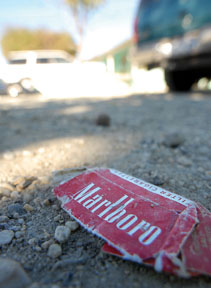County’s Tobacco Education Coalition works to lower use of
products
San Benito County has one of the lowest rates of smoking among
rural counties, according to the results of the California Tobacco
Survey released Dec. 20 by the California Department of Public
Health.
San Benito has a prevalence of 12.1, according to the survey,
conducted in 2008. The rate is down from 15.9 in 1999.
County’s Tobacco Education Coalition works to lower use of products
San Benito County has one of the lowest rates of smoking among rural counties, according to the results of the California Tobacco Survey released Dec. 20 by the California Department of Public Health.
San Benito has a prevalence of 12.1, according to the survey, conducted in 2008. The rate is down from 15.9 in 1999.
“The really good news is that California has made huge successes and gains in reducing smoking rates,” said Carlos Lopez, the San Benito County Tobacco Education project manager. “We have had lots of gains through the adoption of smoking prevention policies.”
In San Benito County, Lopez works with the Tobacco Education Coalition to lower the rate of smoking. In past years the coalition has implemented an ordinance requiring a retailer licensing fee to sell cigarettes to prevent the sale to minors. The group has also implemented a voluntary smoke-free policy at county migrant camps.
This year, the Coalition has been focused on implementing a smoke-free policy for licensed home daycare centers and is creating an anti- tobacco curriculum to use in the middle schools. Lopez said the Coalition is always looking for new members, especially community members who may want to get involved. Anyone interested can call Lopez at 637-5367.
“We need community members, cancer survivors or people who would like to support our goal to keep the percentage low,” Lopez said. “It’s not only the Health Department, but our coalition members working to help support our objective.”
One thing Lopez would like to see California counties focus on is lobbying the Food and Drug Administration to ban menthol cigarettes, which he said target young smokers.
“It masks the hard taste and it’s easier for younger people to get addicted,” he said. “It’s a social justice issue.”
The FDA has banned flavored cigarettes.
He added that an increased cigarette tax may make people question why they smoke or persuade them to try harder to quit. The tax on cigarettes in California is 87 cents per pack, the 30th-highest tax rate among states.
Other nearby counties had higher rates than San Benito. Santa Cruz had a rate of 12.4 percent while Monterey had a rate of 13.3 percent.
Overall the state rate is 13.1 percent, which has gone down 40 percent since the passage of Proposition 99, in 1988. The proposition added a cigarette tax for use in tobacco education and prevention efforts.
Although the smoking prevalence in San Benito County is low, other rural counties did not fare as well. Tehama, a county considered comparable in size, had a rate of 22.8 percent.
“Smoking prevalence tends to be higher in rural counties than urban counties,” said Mark Horton, the state’s health director, in a press release.
State health officials are investigating what may be behind the discrepancy since counties with more than 2,000 people per square mile had a rate of 10.9 percent will those with less than 100 people per square mile had a rate of 15.9 percent.
Lopez said urban smokers or would-be smokers are saturated with social behavior strategies, such as peer pressure, that make smoking unattractive.
“In rural areas, if you’re addicted to smoking, you’re not going to get those daily messages,” Lopez said.
Horton also noted that among smokers, attempts to quit smoking are up. In 2009, 60 percent of smokers said they made a recent attempt to quit and nearly three-quarters of young adults (ages 18-24) tried to stop.
Facts on smoking:
Men smoke at higher rates than women, 15.6 percent compared to 10.7 percent.
College graduates smoke less than non-college graduates with rates of 5.9 percent compared to 12-15 percent.
Households with an income of more than $150,000 smoked at a rate of 7.8 percent, compared to 19.8 percent rate of those making less than $20,000.










